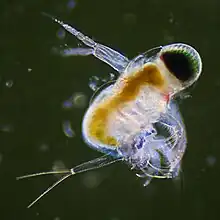| Polyphemus | |
|---|---|
 | |
| Polyphemus pediculus | |
| Scientific classification | |
| Domain: | Eukaryota |
| Kingdom: | Animalia |
| Phylum: | Arthropoda |
| Class: | Branchiopoda |
| Subclass: | Phyllopoda |
| Superorder: | Diplostraca |
| Order: | Onychopoda |
| Family: | Polyphemidae Baird, 1845 |
| Genus: | Polyphemus O. F. Müller, 1785 |
| Species | |
| |
Polyphemus is a genus of water fleas, and the only genus in the family Polyphemidae.[1] There are two species, P. exiguus and P. pediculus, although allopatric speciation has resulted in a number of cryptic species of P. pediculus.[2] Polyphemus exiguus inhabits open zones in the Caspian Sea,[3] while Polyphemus pediculus exists throughout the Holarctic. It lives in diverse conditions, from small ponds to lakes and estuaries such as the Gulf of Saint Lawrence and the Gulf of Finland. It can be found quite far offshore.
Polyphemus are a predatory genus of water flea. The two species have four pairs of legs with exopodites, or outer branches.[3] The legs are adapted for catching mobile prey, generally smaller species of water flea such as young Daphnia and Bosmina.[4]
Polyphemus has two compound eyes that are fused to form a single unit, with a zoned set of receptors.[5] This zoned structure is paired with an eye-control system that allows the Polyphemus to visually distinguish target size to avoid predators and track prey.[4][6] P. pediculus is approximately 1 millimetre (0.04 in) in length. P. exiguus, while similar in morphology, is smaller.
References
- ↑ "Polyphemus (O.F. Müller, 1785)". WoRMS. World Register of Marine Species. 2010. Retrieved March 21, 2012.
- ↑ S. Xu; P. D. N. Hebert; A. A. Kotov; M. E. Critescu (2009). "The noncosmopolitanism paradigm of freshwater zooplankton: insights from the global phylogeography of the predatory cladoceran Polyphemus pediculus (Linnaeus, 1761) (Crustacea, Onychopoda)". Molecular Ecology. 18 (24): 5161–5179. doi:10.1111/j.1365-294X.2009.04422.x. PMID 19912535. S2CID 3899891.
- 1 2 P. D. Mordukhai-Boltovskoi (1968). "On the taxonomy of the Polyphemidae". Crustaceana. 14 (2): 197–209. doi:10.1163/156854068x00601. JSTOR 20102936.
- 1 2 Stephen Young & Victoria A. Taylor (1988). "Visually guided chases in Polyphemus pediculus". Journal of Experimental Biology. 137 (1): 387–398. doi:10.1242/jeb.137.1.387.
- ↑ R. Odselius & D.-E. Nilsson (1983). "Regionally different ommatidial structure in the compound eye of the water-flea Polyphemus (Cladocera, Crustacea)". Proceedings of the Royal Society of London. Series B, Biological Sciences. 217 (1207): 177–189. Bibcode:1983RSPSB.217..177O. doi:10.1098/rspb.1983.0005. JSTOR 35746. S2CID 85572364.
- ↑ Michael F. Land (1992). "Visual tracking and pursuit: humans and arthropods compared". Journal of Insect Physiology. 38 (12): 939–951. doi:10.1016/0022-1910(92)90002-U.